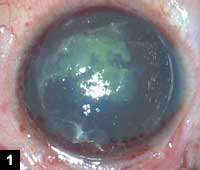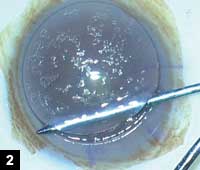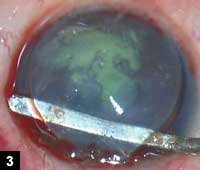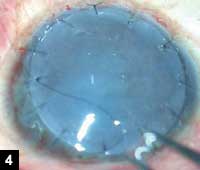Femtosecond-assisted lamellar keratoplasty can treat Avellino corneal dystrophy
Surgeon describes how the technique was used on a young Indian patient with the condition.

Stromal dystrophies, namely granular and lattice dystrophy, were first described in 1890. Femtosecond-assisted lamellar keratoplasty, or FALK, can be performed in some cases such as Avellino corneal dystrophy. To our knowledge, this is the first report of Avellino corneal dystrophy in a young patient of Indian origin treated with FALK using the IntraLase femtosecond laser for donor and recipient cuts.
Avellino corneal dystrophy
 Amar Agarwal |
In 1988, Folberg and colleagues described an atypical granular dystrophy with pathological features of lattice and named it “Avellino” because the patients were from the Italian province of Avellino. There have been reports in the literature about the occurrence of this combined granular and lattice dystrophy in other descents as well. We saw a 6-year-old boy of Indian origin presenting with symptoms of severe corneal erosion, diagnosed as Avellino corneal dystrophy and confirmed by histopathological analysis. The child had a history of redness with watering. When the patient came to our cornea clinic, he was extremely photophobic and could not open his eyes for clinical examination The patient was hospitalized and underwent examination under anesthesia the next day.
In the examination, there were multiple anterior stromal discrete opacities (Figure 1) in the cornea. Some of the opacities were disc shaped, while some were irregular in shape. No specific pattern of involvement was seen. The lesions were mostly located in the central part of the cornea. Few lattice lines were seen in the midperiphery under high magnification with retroillumination. Generalized stromal haze was noted. On staining with 2% fluorescein, epithelial erosions were observed. A bandage contact lens was placed in both eyes with a provisional clinical diagnosis of Avellino corneal dystrophy with recurrent corneal erosion. Topical lubricants were started accordingly.
FALK procedure
FALK treatment was planned for the child. The IntraLase femtosecond laser (Advanced Medical Optics) was used to obtain donor and recipient grafts for lamellar keratoplasty. This is the fourth-generation Intra- Lase femtosecond laser, which uses longer wavelength photo disruption with 60 kHz frequency.
The donor graft (Figure 2), with a depth of 350 µm and a diameter of 8.5 mm, was obtained and then preserved in the moist chamber on the operating table. The recipient corneal tissue was cut (Figure 3) with a depth of 350 µm and a diameter of 8.5 mm. Interrupted sutures (Figure 4) were placed radially equidistant from each other. The corneal buttons were studied histopathologically and proved the diagnosis of Avellino corneal dystrophy. In the immediate postoperative period, corneal graft clarity was good with proper wound apposition. Photophobia decreased after 1 week, with recovery of visual acuity to finger counting.
|
|
|
|
|
Images: Agarwal A |
Discussion
The three characteristic features of Avellino dystrophy are anterior stromal discrete white opacities, lattice lesions located in mid and posterior stroma, and anterior stromal haze. Avellino is a type 2 variant of granular corneal dystrophies with mutations in the TGFBI gene (TGFBI or BIGH3, transforming growth factor-ß induced) on chromosome 5 at q31. This case report is unique because the patient was treated with FALK, which has not been reported so far. The IntraLase laser has been used to obtain the donor and host tissue. IntraLase has been well reported in penetrating keratoplasty for corneal dystrophy. The advantage of using a femtosecond laser is the smooth and uniform depth obtained in the corneal bed. It has been described that the IntraLase provides depth and diameter accuracy even at increased depth settings in lamellar keratoplasty.
Conclusion
There were no preoperative or postoperative complications noted in our patient. Graft clarity and graft host junction apposition were good. The patient improved symptomatically by opening his eyes on the first postoperative day while his visual acuity improved gradually within a week.
For More Information:
- Amar Agarwal, MS, FRCS, FRCOphth is director of Dr. Agarwal’s Group of Eye Hospitals. Prof. Agarwal is author of several books published by SLACK, Incorporated, publisher of Ocular Surgery News, including Phaco Nightmares: Conquering Cataract Catastrophes, Bimanual Phaco: Mastering the Phakonit/MICS Technique, Dry Eye: A Practical Guide to Ocular Surface Disorders and Stem Cell Surgery, and Presbyopia: A Surgical Textbook. He can be reached at 19 Cathedral Road, Chennai 600 086, India; fax: 91-44-28115871; e-mail: dragarwal@vsnl.com; Web site: www.dragarwal.com.
References:
- Agarwal A. Handbook of Ophthalmology. Thorofare, NJ: SLACK Incorporated; 2005.
- Agarwal S, Agarwal A, Agarwal A. Four volume textbook of ophthalmology. India: Jaypee; 2000.
- Folberg R, Alfonso E, et al. Clinically atypical granular corneal dystrophy with pathologic features of lattice-like amyloid deposits. A study of these families. Ophthalmology. 1988;95(1):46-51.




